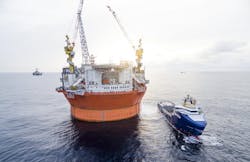Goliat supply vessel connected to shore power
Offshore staff
SANDNES, Norway – First-phase work to upgrade the supply vessel Stril Barents for a carbon dioxide (CO2) reduction program has finished.
The vessel is supporting operations at theGoliat platform in the Barents Sea, which operator Vår Energi (formerly Eni Norge/Point Resources) claims has one of the lowest CO2 emissions of any field offshore Norway.
Vår and the vessel owner Simon Møkster Shipping commissioned the upgrade last November.
It involves installation of a shore power connection and a new battery arrangement for onboard energy storage on board.
The shore power connection has been tested and is operational, reducing the vessel’s fuel consumption and CO2 emissions while it is docked at the Polarbase supply base in Hammerfest, northern Norway.
In addition, the solution contributes to lower noise pollution, Vår said.
The system for charging the ship’s battery pack will be completed this summer, further reducing fuel consumption during transit and field operations.
Once the work is completed, the longer-term goal is to cut theStril Barents’s CO2 emissions by 1,400 metric tons/yr (1,543 tons), and its nitrogen oxide (NOx) emissions by 12 metric tons/yr (13.2 tons).
Goliat is partly electrified through one of the world’s longest subsea electric cables to an offshore platform, with an average CO2 emission last year of around 2 kg/bbl of oil produced.
This compares with an average figure of 8-9 kg/bbl on other fields across the Norwegian shelf, according to 2017 figures, Vår claimed.
TheStril Barents is designed to run on LNG.
01/25/2019
